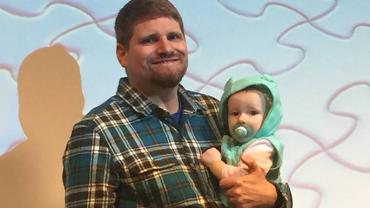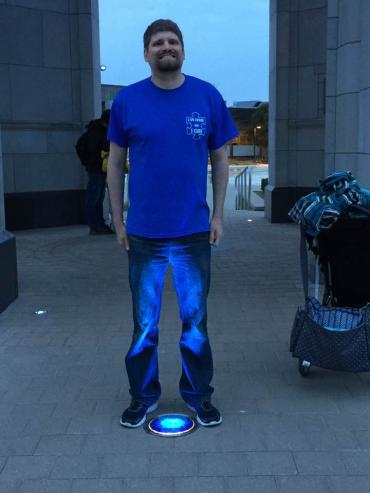What Light It Up Blue means to me
By Ron SandisonThis guest blog is by Ron Sandison, an adult on the autism spectrum who works full time in the medical field and is a professor of theology at Destiny School of Ministry. This post is part of an initiative on our site called “In Our Own Words: Living on the Spectrum,” which highlights the experiences of individuals with autism from their perspectives.
As a young child autism made me feel different and like an endangered species. At age seven my speech was so delayed my brother Chuck would boast to his friends, “Meet my brother Ronnie—I think he is from Norway since he speaks Norwegian.” Academically I was so delayed the school experts warned my parents I would probably never read beyond a seventh grade age level or attend college.
My poor social skills in middle school caused me to feel like an outcast and I feared I would always be single like the Galápagos giant tortoise—nicknamed Lonesome George since he was the only known survivor of the Pinta Island species found in the Galápagos Island.
When I was six-years-old, I was obsessed with the book No Man’s Valley written by Laura McCarley, and also the 1981 animated, special movie based on the book. After my mom’s nightly Bible stories she would read this short book to me. The storyline for No Man’s Valley is about a California condor Elliot who goes on an adventure to find Utopia where extinct and endangered species can live safely away from the dangers of humans. I wished to be part of this community also.
Having autism I could relate with Elliot the condor. In my room, I built my own No Man’s Valley with a blanket covering a coffee table. On top of the table was a moving animal train and a watchtower composed of Legos. This utopia was complete with Prairie Pup (the mayor) and all my favorite critters. When I experienced fear or anxiety, I entered No Man’s Valley through its blanket door, and I felt calm. No Man’s Valley was a stress-free environment where I could hide away from the world and read and write my creative animal adventures. If anyone touched No Man’s Valley or moved the animals from their exact place, I would experience a meltdown.
My mom joked, “I kept having nightmares that Ronnie’s No Man’s Valley would move out from his room and take over the whole house.” It is not uncommon for a child with autism to invent a device to relieve his or her stress and anxiety.
When Temple Grandin was in college, she invented a squeeze chute to help her overcome autism processing sensory issues. This human chute was designed based on the ones used for cattle. The squeeze chute provided her relief from panic attacks and also stimulated her mind for thinking and studying.
My creation of No Man’s Valley enabled my imagination and creativity to blossom. The themes from the book and movie, No Man’s Valley, were concepts that helped me overcome my learning disabilities, social awkwardness, and grow in faith.
As the dialog between the Elder/chief California condor with the younger condor, Elliot, encourages children:
There is a place far, far away where endangered and existent animals can go safe from the problems of the outside world. It’s called No Man’s Valley. All I know is to reach it. You must have faith and the will to survive, endurance beyond belief and the courage to overcome hardship, terror, and obstacles too horrible to describe. Only you can fly there and complete the journey.
Light It Up Blue in April
Light It Up Blue and World Autism Month in April is a reminder for me that we in the autism community are not alone and isolated from society like an endanger species but part of an amazing community composed of people with great talents. I no longer need to dream of discovering a utopia free from humans. I am a part of a loving support network with other individuals who also struggle with sensory issues, anxiety, depression, and social interaction. When I see the blue lights, I realize I am also a piece of the puzzle-fitting in—I can say with joy, “Light up Blue!”










